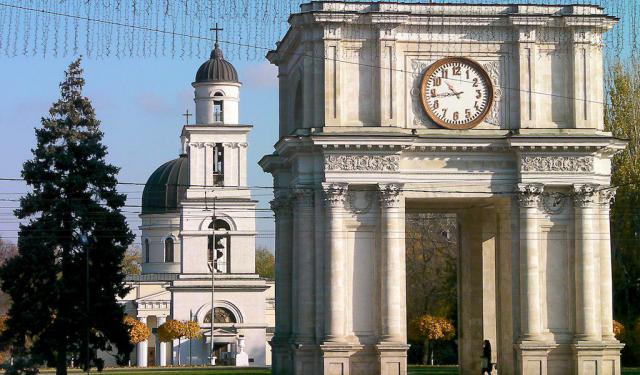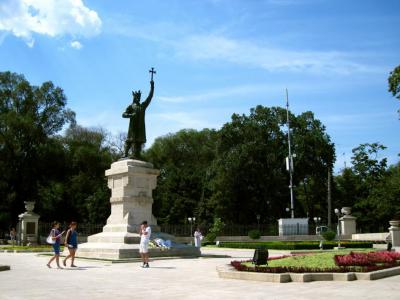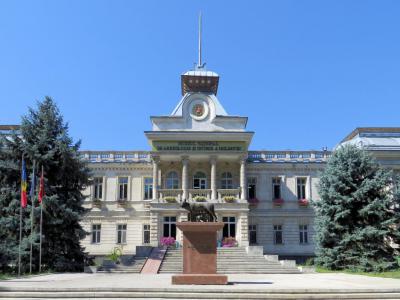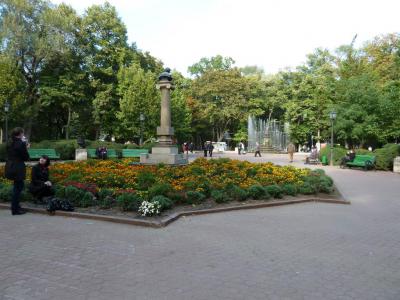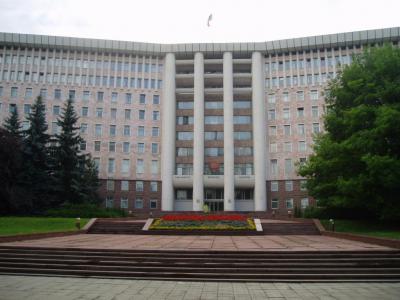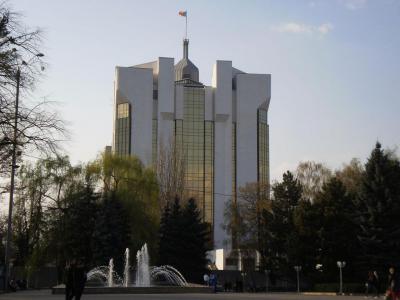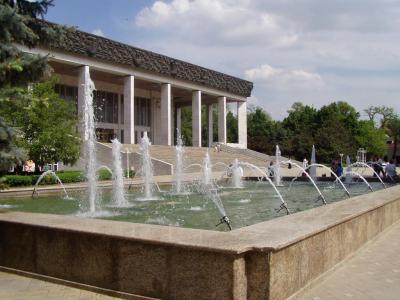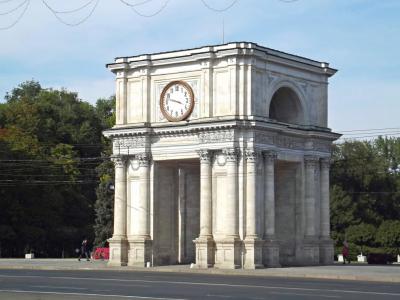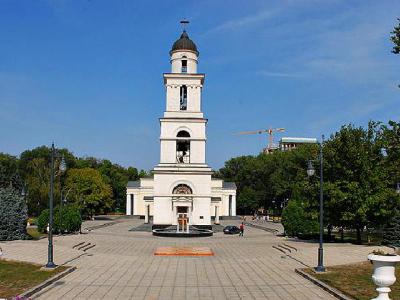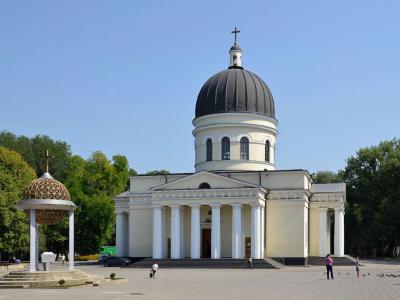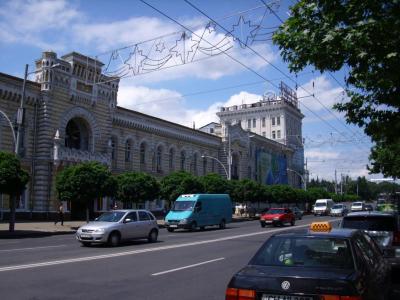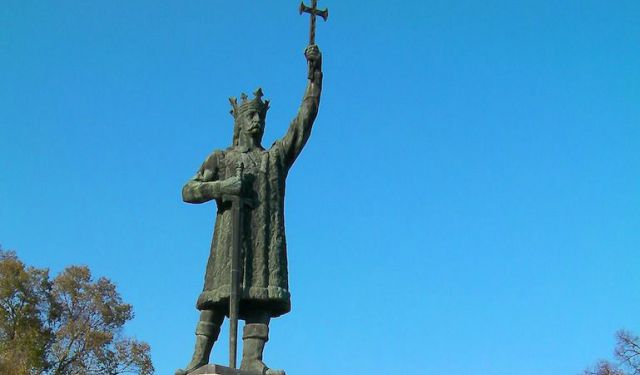Audio Guide: Chisinau Introduction Walking Tour (Self Guided), Chisinau
Chisinau is the capital of Moldova, a small nation in Eastern Europe landlocked between Romania and Ukraine. For many years this land had been part of the Russian Empire and then the Soviet Union, until it finally gained independence in 1991. For this reason the city is also often referred to as Kishinev, which is the Russian version of the name.
While the true origin of the name is unclear, many believe that it came from the Romanian words chișla (which is archaic for "water spring") and nouă (which means "new"), and it refers to Chisinau's origin as a monastery village built around a small spring in 1436.
Initially, Chisinau was part of the Principality of Moldavia, which in the 16th century became a vassal state of the Ottoman Empire. Following the Russo-Turkish War of 1806–1812, the Ottomans ceded territory, thence known as Bessarabia, to the Russian Empire.
The Russians made Chisinau the capital of Bessarabia province, which by the mid 1830s emerged as an imperial outpost with broad, long roads and other key infrastructure. The renewed city center was anchored by the neoclassical, dome-topped Nativity Cathedral, built between 1830 and 1836, complete with a magnificent belfry in the Cathedral Park. In 1846, another landmark – the Triumphal Arch, celebrating Russia's victory over the Turks – was added to a nearby plaza.
After the Russian Revolution, Bessarabia joined the Romanian Kingdom in 1919, following which Chisinau became Romania's second largest city. Between 1918 and 1940, the downtown area underwent vast renovation. In 1927, the Stefan the Great Monument was erected to commemorate Moldova's national hero, the saint prince who fiercely opposed the Ottoman rule in the 15th century. This monument now stands outside the park named in his honor.
From 1940 to 1944, Chisinau and Bessarabia had changed hands several times between Romania and the Soviet Union, until eventually both became part of the USSR. Throughout 1947-1949, the city – then still heavily damaged by air raids in WWII – underwent gradual reconstruction. The large-scale housing construction of the 1950s and 60s was followed by the grand palatial projects of the 1970s-90s producing landmarks like the Parliament Building, Presidential Palace, the National Opera and Ballet Theater, and others.
If you wish to acquaint yourself more closely with these and other notable sights of the Moldovan capital and to learn more about this relatively little known travel destination, take our self-guided introductory walk!
While the true origin of the name is unclear, many believe that it came from the Romanian words chișla (which is archaic for "water spring") and nouă (which means "new"), and it refers to Chisinau's origin as a monastery village built around a small spring in 1436.
Initially, Chisinau was part of the Principality of Moldavia, which in the 16th century became a vassal state of the Ottoman Empire. Following the Russo-Turkish War of 1806–1812, the Ottomans ceded territory, thence known as Bessarabia, to the Russian Empire.
The Russians made Chisinau the capital of Bessarabia province, which by the mid 1830s emerged as an imperial outpost with broad, long roads and other key infrastructure. The renewed city center was anchored by the neoclassical, dome-topped Nativity Cathedral, built between 1830 and 1836, complete with a magnificent belfry in the Cathedral Park. In 1846, another landmark – the Triumphal Arch, celebrating Russia's victory over the Turks – was added to a nearby plaza.
After the Russian Revolution, Bessarabia joined the Romanian Kingdom in 1919, following which Chisinau became Romania's second largest city. Between 1918 and 1940, the downtown area underwent vast renovation. In 1927, the Stefan the Great Monument was erected to commemorate Moldova's national hero, the saint prince who fiercely opposed the Ottoman rule in the 15th century. This monument now stands outside the park named in his honor.
From 1940 to 1944, Chisinau and Bessarabia had changed hands several times between Romania and the Soviet Union, until eventually both became part of the USSR. Throughout 1947-1949, the city – then still heavily damaged by air raids in WWII – underwent gradual reconstruction. The large-scale housing construction of the 1950s and 60s was followed by the grand palatial projects of the 1970s-90s producing landmarks like the Parliament Building, Presidential Palace, the National Opera and Ballet Theater, and others.
If you wish to acquaint yourself more closely with these and other notable sights of the Moldovan capital and to learn more about this relatively little known travel destination, take our self-guided introductory walk!
How it works: Download the app "GPSmyCity: Walks in 1K+ Cities" from Apple App Store or Google Play Store to your mobile phone or tablet. The app turns your mobile device into a personal tour guide and its built-in GPS navigation functions guide you from one tour stop to next. The app works offline, so no data plan is needed when traveling abroad.
Chisinau Introduction Walking Tour Map
Guide Name: Chisinau Introduction Walking Tour
Guide Location: Moldova » Chisinau (See other walking tours in Chisinau)
Guide Type: Self-guided Walking Tour (Sightseeing)
# of Attractions: 10
Tour Duration: 2 Hour(s)
Travel Distance: 2.4 Km or 1.5 Miles
Author: DanaOffice
Sight(s) Featured in This Guide:
Guide Location: Moldova » Chisinau (See other walking tours in Chisinau)
Guide Type: Self-guided Walking Tour (Sightseeing)
# of Attractions: 10
Tour Duration: 2 Hour(s)
Travel Distance: 2.4 Km or 1.5 Miles
Author: DanaOffice
Sight(s) Featured in This Guide:
- Stefan the Great Monument
- National History Museum
- Stephen the Great Park
- Parliament Building
- Presidential Palace
- National Opera and Ballet Theatre
- Triumphal Arch
- Bell Tower
- Nativity Cathedral
- Stefan cel Mare Blvd
1) Stefan the Great Monument (must see)
The bronze monument of Stefan the Great (or Stefan cel Mare as it's known locally) outside the main entrance to the park bearing the same name in downtown Chisinau commemorates Moldova's national hero – the ancient ruler, who, in the 15th century, successfully defended the country from Turkish invasion. The statue was cast in Bucharest in the early 20th century and was intended to replace the monument to the Russian Emperor Alexander II which had previously stood in this place and was demolished by Romanian authorities after Moldova had joined the Romanian Kingdom in 1918.
The sculpture was created by Alexandru Plamadeala who had traveled far and wide, prior to starting the job, in order to find a portrait of Stefan cel Mare. They say, the sculptor made three different copies of the monument, one of which stands today. Over the years, the sculpture has been moved several times from place to place. Shortly before the Soviet invasion of Bessarabia in 1940, it was taken to Vaslui in the eastern part of Romania, and then returned to Chisinau in 1942. Then, in 1944, it was once again dispatched to Romania. Finally, after a very long while, in 1989, the monument was restored in its original place in Chisinau. Today, the sculpture represents one of the top tourist sights in Moldovan capital and is a popular meeting point with locals, often visited by foreign guests, wedding couples and others.
The sculpture was created by Alexandru Plamadeala who had traveled far and wide, prior to starting the job, in order to find a portrait of Stefan cel Mare. They say, the sculptor made three different copies of the monument, one of which stands today. Over the years, the sculpture has been moved several times from place to place. Shortly before the Soviet invasion of Bessarabia in 1940, it was taken to Vaslui in the eastern part of Romania, and then returned to Chisinau in 1942. Then, in 1944, it was once again dispatched to Romania. Finally, after a very long while, in 1989, the monument was restored in its original place in Chisinau. Today, the sculpture represents one of the top tourist sights in Moldovan capital and is a popular meeting point with locals, often visited by foreign guests, wedding couples and others.
2) National History Museum
The National History Museum of Moldova occupies the building of the former Regional Lyceum, and was opened in 1987. In front of the building stands the replica of the legendary Capitoline Wolf monument, depicting infant twins Romulus and Remus being suckled by the Roman she-wolf.
The museum has 10 exhibition halls and is divided into several theme sections, such as Archaeology and Ancient History, Medieval History, History of Bessarabia, Contemporary History, and Treasury.
The entire collection comprises over 260,000 exhibits and includes archaeological findings, documents, photographs, coins, everyday objects, decorative and artisanal works, and others. More than half of these items are qualified as "national treasure". In addition to permanent collection, each year the museum hosts about a dozen temporary exhibitions, all of which represent important events in the country's cultural life.
The museum offers tours in both Romanian and Russian. Upon request, a guide-interpreter service can be provided; this is particularly useful since all the exhibits are accompanied with descriptions only in Romanian.
Tip:
You should buy three tickets if you want to take photos.
The museum has 10 exhibition halls and is divided into several theme sections, such as Archaeology and Ancient History, Medieval History, History of Bessarabia, Contemporary History, and Treasury.
The entire collection comprises over 260,000 exhibits and includes archaeological findings, documents, photographs, coins, everyday objects, decorative and artisanal works, and others. More than half of these items are qualified as "national treasure". In addition to permanent collection, each year the museum hosts about a dozen temporary exhibitions, all of which represent important events in the country's cultural life.
The museum offers tours in both Romanian and Russian. Upon request, a guide-interpreter service can be provided; this is particularly useful since all the exhibits are accompanied with descriptions only in Romanian.
Tip:
You should buy three tickets if you want to take photos.
3) Stephen the Great Park (must see)
Stefan cel Mare Park in Chisinau is undoubtedly the right place for those keen on a quiet stroll in the oasis of greenery amid the busy city. Spread over 17 acres of land, this park finds itself wedged between the Government House in the east and the House of Parliament in the west, and is bounded by Stefan cel Mare Boulevard and August 31st Street.
Oldest in town, the park was established in 1818 by the Russian Army Engineer Corps, and was later remodeled into its current shape by architect Alexander Bernardazzi. For many years the park was known as Pushkin Park, named after the great Russian poet, Alexander Pushkin, who spent several years in exile in Chisinau in the 1820s. The bust of Pushkin still marks the center of the park – it was created through public subscription by the well-known Russian sculptor, Alexander Mikhailovich Opekushin, in 1885. As the matter of fact, Chisinau was the second city in the whole of the Russian Empire, after Moscow, to have a statue commemorating the poet.
Nearby, within the park, is the Alley of Classics of Moldovan Literature. Opened in 1958, this Alley features monuments to the key Moldovan authors such as Mihai Eminescu, Grigore Vieru and others.
Presently, the park is also jokingly referred to as the “lovers' park” for being one of the most popular hangouts of the young people who come here regularly to meet, chat and spend time kindling their relationship.
Oldest in town, the park was established in 1818 by the Russian Army Engineer Corps, and was later remodeled into its current shape by architect Alexander Bernardazzi. For many years the park was known as Pushkin Park, named after the great Russian poet, Alexander Pushkin, who spent several years in exile in Chisinau in the 1820s. The bust of Pushkin still marks the center of the park – it was created through public subscription by the well-known Russian sculptor, Alexander Mikhailovich Opekushin, in 1885. As the matter of fact, Chisinau was the second city in the whole of the Russian Empire, after Moscow, to have a statue commemorating the poet.
Nearby, within the park, is the Alley of Classics of Moldovan Literature. Opened in 1958, this Alley features monuments to the key Moldovan authors such as Mihai Eminescu, Grigore Vieru and others.
Presently, the park is also jokingly referred to as the “lovers' park” for being one of the most popular hangouts of the young people who come here regularly to meet, chat and spend time kindling their relationship.
4) Parliament Building
Built during the Soviet period, from 1976-1979, this former headquarters of the once mighty Communist Party today houses Moldova's national parliament. The building features the shape of an open book with the central part of its façade supported by four high-standing vertical columns. In the spring of 2009 the building came under attack by rioting students in what came to be known as the "Twitter Revolution". After substantial repairs done in the following three years, the Parliament moved back in and resumed work in February 2014.
5) Presidential Palace
Presidential Palace in Chisinau is a relatively new object of national importance. Erected from 1984-1987, this glass-clad building was designed originally to accommodate the Supreme Council of the Moldavian Soviet Republic. After Moldova gained independence in 1991, the Palace was converted to house the office of the country's President.
The building was heavily damaged during protest on April 7, 2009, which was held against the then President Vladimir Voronin. The building had to be closed off for several years after that, pending reparation. During the tenure of President Igor Dodon, the Palace was renovated with the help of the Turkish government and was finally reopened, on October 17, 2018, in the presence of Turkish President Recep Tayyip Erdogan.
The building was heavily damaged during protest on April 7, 2009, which was held against the then President Vladimir Voronin. The building had to be closed off for several years after that, pending reparation. During the tenure of President Igor Dodon, the Palace was renovated with the help of the Turkish government and was finally reopened, on October 17, 2018, in the presence of Turkish President Recep Tayyip Erdogan.
6) National Opera and Ballet Theatre
Overlooking the Stefan cel Mare Boulevard in Chisinau is one of major opera and ballet theaters in Eastern Europe – the National Opera and Ballet of Moldova. After the collapse of the Soviet Union in the early 90s, this theater was one of the few on the post-Soviet territory to retain its ballet, opera and orchestra troupe, complete with all the soloists and chorus, as well as the equipment.
In 2012, the theater was named after the renowned local opera diva Maria Bieșu, whose artistic excellence brought her international recognition; from 1965 to 1967 she had performed at the La Scala Opera in Milan.
Presently, the theater employs a group of talented singers and dancers, both seasoned professionals and young graduates from the local Choreographic College and Music Conservatory. In recent years, the company has toured far and wide, throughout Europe and further afield, including countries like Italy, Romania, Bulgaria, Portugal, France, Spain, Britain, and others. Given the breadth of their repertoire, the Theater has no problem catering to the wishes of foreign impresarios, focused on specific national tastes.
Why You Should Visit:
The theater is regularly sold out, which only adds to the atmosphere; ticket prices are usually 10% of what you pay for a similar show in London, so you get excellent value for money.
Ticket Office Hours:
Mon-Fri: 11am-6pm; Sat, Sun: 11am-4pm
With lunch break between 1-2pm
In 2012, the theater was named after the renowned local opera diva Maria Bieșu, whose artistic excellence brought her international recognition; from 1965 to 1967 she had performed at the La Scala Opera in Milan.
Presently, the theater employs a group of talented singers and dancers, both seasoned professionals and young graduates from the local Choreographic College and Music Conservatory. In recent years, the company has toured far and wide, throughout Europe and further afield, including countries like Italy, Romania, Bulgaria, Portugal, France, Spain, Britain, and others. Given the breadth of their repertoire, the Theater has no problem catering to the wishes of foreign impresarios, focused on specific national tastes.
Why You Should Visit:
The theater is regularly sold out, which only adds to the atmosphere; ticket prices are usually 10% of what you pay for a similar show in London, so you get excellent value for money.
Ticket Office Hours:
Mon-Fri: 11am-6pm; Sat, Sun: 11am-4pm
With lunch break between 1-2pm
7) Triumphal Arch (must see)
Also known as the Holy Gate, the Triumphal Arch is yet another historic monument in the heart of Chisinau. It was built in 1846 to commemorate victory of the Russian forces over the Turkish Army in the 1820s. The Arch overlooks the Government House on Stefan cel Mare Boulevard from across the Great National Assembly Square.
The structure has a classic, square-shaped form, 13 meters in height and is distinctly divided into two tiers. The lower tier comprises four sturdy pylons, ornately decorated with classic Corinthian columns, which give the construction its regal look. It also features a beautiful clock on the side, which chimes every fifteen minutes.
Aside from its architectural value, the Arch is also noted for its fascinating history. After the Russians defeated Turks in 1829, Tsar Nikolai I, acting on request of General Vorontsov, one of the most prominent war veterans, ordered to make bells from the captured Turkish canons. These bells were to be installed inside the Arch. However, upon their completion, the bells proved to be too big for the Arch and therefore a separate belfry had to be constructed nearby specially for them.
Why You Should Visit:
Historical significance aside, it is quite refreshing to find a monument of this type in Moldova. You can't go in it or up it, but it gives a little relief to the city itself.
Quite successful in its miniature form and a must-see of the Moldavian Champs-Élysées as it marks the dead center of the city.
Tip:
Take a walk to see it at dusk, when it is beautifully lit. You can also spend some time in the very nice park nearby.
The structure has a classic, square-shaped form, 13 meters in height and is distinctly divided into two tiers. The lower tier comprises four sturdy pylons, ornately decorated with classic Corinthian columns, which give the construction its regal look. It also features a beautiful clock on the side, which chimes every fifteen minutes.
Aside from its architectural value, the Arch is also noted for its fascinating history. After the Russians defeated Turks in 1829, Tsar Nikolai I, acting on request of General Vorontsov, one of the most prominent war veterans, ordered to make bells from the captured Turkish canons. These bells were to be installed inside the Arch. However, upon their completion, the bells proved to be too big for the Arch and therefore a separate belfry had to be constructed nearby specially for them.
Why You Should Visit:
Historical significance aside, it is quite refreshing to find a monument of this type in Moldova. You can't go in it or up it, but it gives a little relief to the city itself.
Quite successful in its miniature form and a must-see of the Moldavian Champs-Élysées as it marks the dead center of the city.
Tip:
Take a walk to see it at dusk, when it is beautifully lit. You can also spend some time in the very nice park nearby.
8) Bell Tower
Situated directly behind the Holy Gates, opposite the Cathedral, is a beautiful bell tower, an important religious and historic site in Chisinau.
This Belfry is the exact replica of its predecessor that was built on this site in the 1830s (along with the nearby Cathedral). The original tower was fitted with the bells made from the Turkish cannons captured during the Russo-Turkish war of 1828-1829.
Sadly, the first belfry was demolished in 1962, during the Soviet reign, under Nikita Khrushchev, and was replaced with a flower bed. Officially, this was done in a bid to prevent anybody from using the tower as a firing position should anyone ever contemplated murdering government officials sitting in the Government House on the opposite side of the square.
In the post-Soviet era, in 1998, the bell tower was rebuilt. It stands four stories high, has several bells at the top, and a small chapel on the ground floor.
Tip:
Note the surrounding flowerbeds; if you want to buy flowers, check out the stalls on the side of the park.
This Belfry is the exact replica of its predecessor that was built on this site in the 1830s (along with the nearby Cathedral). The original tower was fitted with the bells made from the Turkish cannons captured during the Russo-Turkish war of 1828-1829.
Sadly, the first belfry was demolished in 1962, during the Soviet reign, under Nikita Khrushchev, and was replaced with a flower bed. Officially, this was done in a bid to prevent anybody from using the tower as a firing position should anyone ever contemplated murdering government officials sitting in the Government House on the opposite side of the square.
In the post-Soviet era, in 1998, the bell tower was rebuilt. It stands four stories high, has several bells at the top, and a small chapel on the ground floor.
Tip:
Note the surrounding flowerbeds; if you want to buy flowers, check out the stalls on the side of the park.
9) Nativity Cathedral (must see)
The Nativity Cathedral in Chisinau is a fine piece of Russian architecture, dating back to the early 19th century. Just like most religious sites in the city during the Soviet period, the Cathedral building was converted to a secular use and served as an exhibition center. Following the collapse of the Soviet Union, it has resumed service as a place of worship for the local Orthodox congregation.
Construction on the Cathedral was commissioned by Prince Mikhail Semyonovich Vorontsov, the governor-general of Novorossiya (or New Russia) region of the Russian Empire back in the 1830s, and was led by architect Avraam Melnikov, one of the country's finest architects at the time. Given the importance of the project, great care was taken to ensure the building's elegant, regal and timeless appearance. As such, the Cathedral features eclectic style, a combination of Byzantine elements with a hint of Renaissance on a Greek Cross, which is a perfect brew for neoclassical design.
Over the centuries, this remarkable edifice has sustained multiple damages caused by wars and political upheavals following the demise of, first, the Russian Empire and then the Soviet Union. Today, the Cathedral stands as the main temple of the Russian Orthodox Church in Chisinau and is a definite must-see attraction for any architecture buff visiting the city.
Why You Should Visit:
Set in front of the nice square (good for meditating and/or people watching), the structure appears quite large and simple from the outside, but on the inside it is rather small, yet brightly lit – a perfect example of Orthodox cathedral architecture.
Construction on the Cathedral was commissioned by Prince Mikhail Semyonovich Vorontsov, the governor-general of Novorossiya (or New Russia) region of the Russian Empire back in the 1830s, and was led by architect Avraam Melnikov, one of the country's finest architects at the time. Given the importance of the project, great care was taken to ensure the building's elegant, regal and timeless appearance. As such, the Cathedral features eclectic style, a combination of Byzantine elements with a hint of Renaissance on a Greek Cross, which is a perfect brew for neoclassical design.
Over the centuries, this remarkable edifice has sustained multiple damages caused by wars and political upheavals following the demise of, first, the Russian Empire and then the Soviet Union. Today, the Cathedral stands as the main temple of the Russian Orthodox Church in Chisinau and is a definite must-see attraction for any architecture buff visiting the city.
Why You Should Visit:
Set in front of the nice square (good for meditating and/or people watching), the structure appears quite large and simple from the outside, but on the inside it is rather small, yet brightly lit – a perfect example of Orthodox cathedral architecture.
10) Stefan cel Mare Blvd
Stefan cel Mare Boulevard is arguably the most prominent streets of the Moldovan capital. The 3.8-km thoroughfare is lined with numerous buildings of social and political importance, cultural institutions, shops, and restaurants.
Historically, it is believed to have stemmed from the road that led into the city from the Russian military camp stationed to the west of Chisinau in 1789. Long before the city plan was adopted by Russian Emperor Alexander II in 1834, the construction of the Nativity Cathedral started together with the Public Garden (now known as Stefan cel Mare Park) and many other locations nearby.
Over the years, the street has changed several names, starting from Millionnaia in the early 19th century to Moskovskaia (between 1840 and 1877), followed by Aleksandrovskaia (between 1877 and 1924), then Alexandru cel Bun Boulevard (between 1924 and 1931), King Carol II Boulevard (between 1931 and 1944), Lenin Street (between 1944 and 1952) and Lenin Boulevard (between 1952 and 1990) until finally, following the country's independence in 1991, becoming Stefan cel Mare Boulevard – named after of the ancient ruler of Moldova, prince Stephen the Great during 1457 to 1504.
Historically, it is believed to have stemmed from the road that led into the city from the Russian military camp stationed to the west of Chisinau in 1789. Long before the city plan was adopted by Russian Emperor Alexander II in 1834, the construction of the Nativity Cathedral started together with the Public Garden (now known as Stefan cel Mare Park) and many other locations nearby.
Over the years, the street has changed several names, starting from Millionnaia in the early 19th century to Moskovskaia (between 1840 and 1877), followed by Aleksandrovskaia (between 1877 and 1924), then Alexandru cel Bun Boulevard (between 1924 and 1931), King Carol II Boulevard (between 1931 and 1944), Lenin Street (between 1944 and 1952) and Lenin Boulevard (between 1952 and 1990) until finally, following the country's independence in 1991, becoming Stefan cel Mare Boulevard – named after of the ancient ruler of Moldova, prince Stephen the Great during 1457 to 1504.
Walking Tours in Chisinau, Moldova
Create Your Own Walk in Chisinau
Creating your own self-guided walk in Chisinau is easy and fun. Choose the city attractions that you want to see and a walk route map will be created just for you. You can even set your hotel as the start point of the walk.
Bernardazzi Architecture Walking Tour
Talented people are often able to leave their mark in the hearts of the posterity long after they are gone. Centuries fly but the power of the beauty persists, especially if set in the stones of the buildings designed by distinguished architects. Moldova's capital is blessed in this respect as the place associated with Alexander Bernardazzi, a Russian architect of Swiss-Italian descent who... view more
Tour Duration: 1 Hour(s)
Travel Distance: 2.4 Km or 1.5 Miles
Tour Duration: 1 Hour(s)
Travel Distance: 2.4 Km or 1.5 Miles
Chisinau Historical Sites
Although the history of Chisinau accounts for just over 500 years, whilst that of Moldova, as a nation, even less than that – since 1991, Moldovan culture and language are deeply rooted in the ancient Roman tradition. Just as the Eternal City, Chisinau rests on seven hills – in the valley of the River Bic, and has a replica statue of the Capitoline Wolf in the downtown area. Whereas most of... view more
Tour Duration: 3 Hour(s)
Travel Distance: 5.5 Km or 3.4 Miles
Tour Duration: 3 Hour(s)
Travel Distance: 5.5 Km or 3.4 Miles
Stefan cel Mare Blvd Walk
Stefan cel Mare Boulevard is arguably the most prominent streets of the Moldovan capital. The 3.8-km thoroughfare is lined with numerous buildings of social and political importance, cultural institutions, shops, and restaurants.
Historically, it is believed to have stemmed from the road that led into the city from the Russian military camp stationed to the west of Chisinau in 1789. Long before... view more
Tour Duration: 2 Hour(s)
Travel Distance: 3.6 Km or 2.2 Miles
Historically, it is believed to have stemmed from the road that led into the city from the Russian military camp stationed to the west of Chisinau in 1789. Long before... view more
Tour Duration: 2 Hour(s)
Travel Distance: 3.6 Km or 2.2 Miles
Best Wine and Brandy Shops
Given the lack of stunning scenery – no turquoise waters or snow-clad mountains – Moldova is a country not overrun by tourists. Still, those who come here, usually do so to taste the local wines and brandies – Moldova is a seasoned grape and spirit producer. The locals are very lovable and hospitable people, genuinely ready to delight strangers with their internationally-renowned booze. Here... view more
Tour Duration: 1 Hour(s)
Travel Distance: 3.0 Km or 1.9 Miles
Tour Duration: 1 Hour(s)
Travel Distance: 3.0 Km or 1.9 Miles
Useful Travel Guides for Planning Your Trip
Chisinau Shopping Guide: 20 Moldovan Products to Take Home
Once part of the Soviet Union, now independent Moldova is a small country sandwiched between Romania and Ukraine, of which still very little is known. To mend this, the country has recently opened borders to the outside world. Be sure to take advantage of this opportunity and acquaint yourself with...
The Most Popular Cities
/ view all
